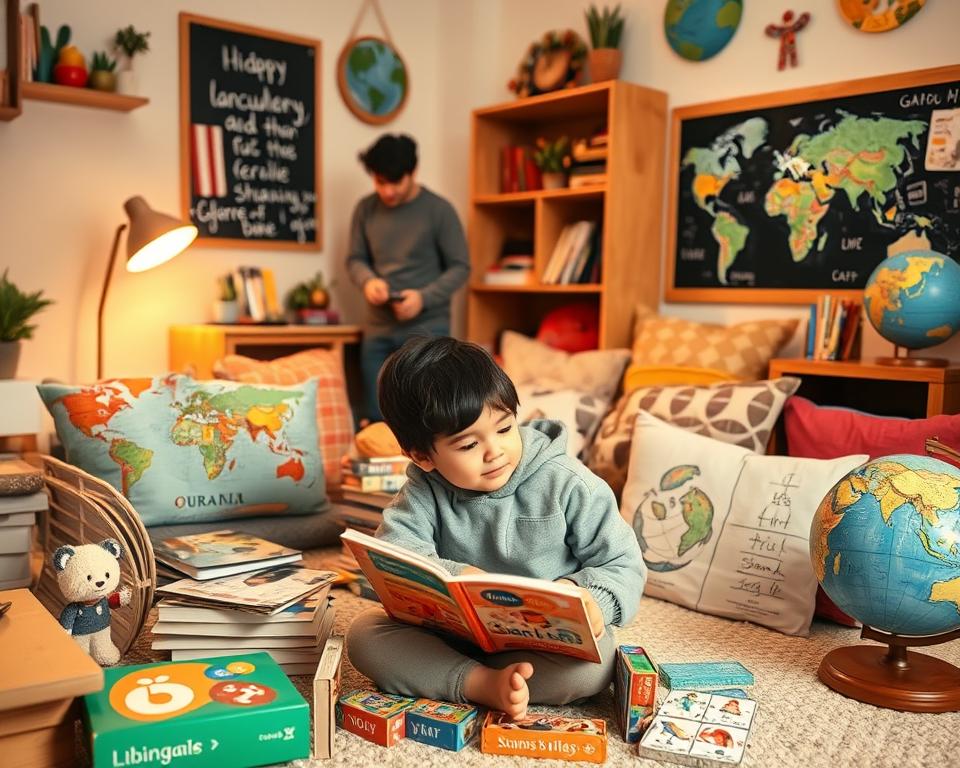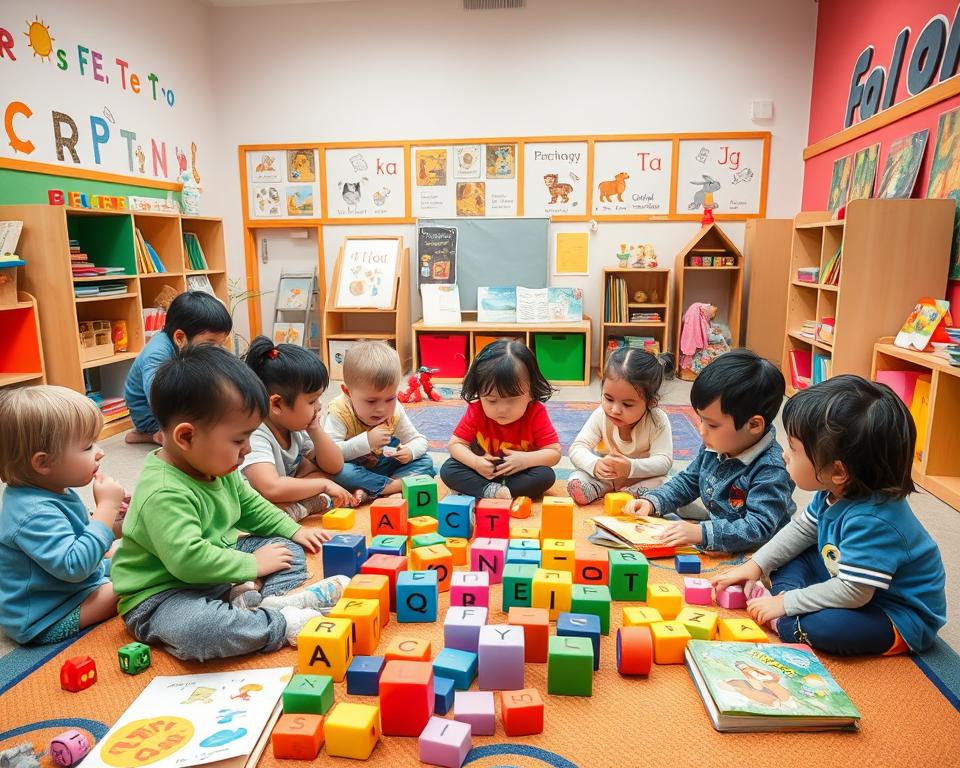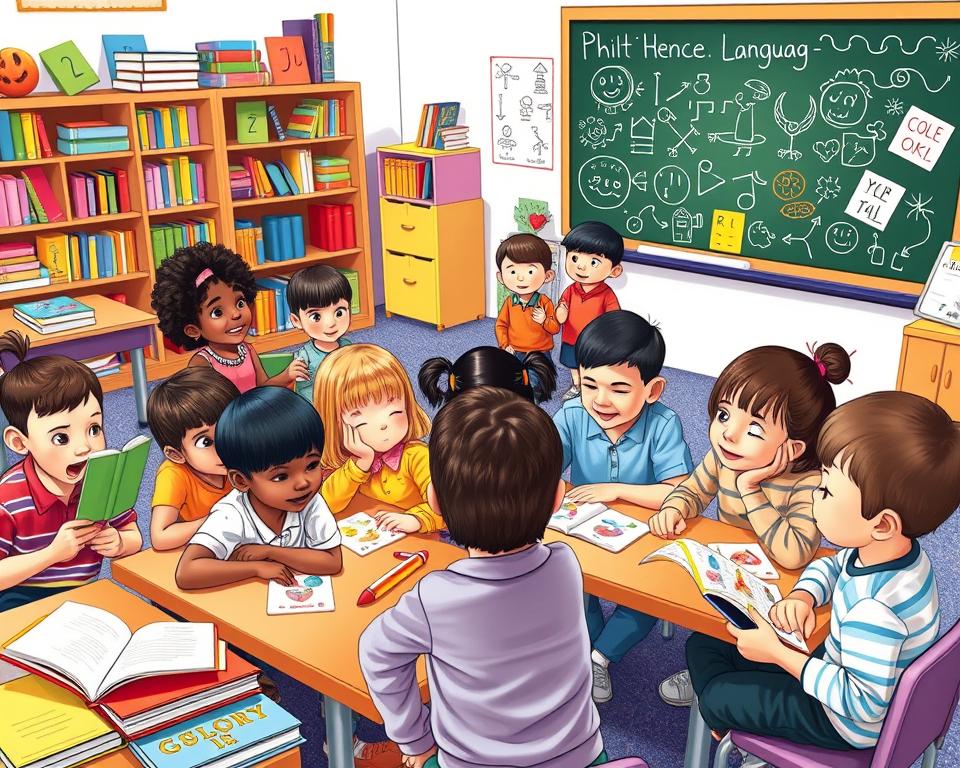Did you know that Spanish-speaking English Language Learners (ELLs) often struggle with sounds that don’t exist in their native language? This shows how important parents are in helping their kids learn a new language. Learning a new language provides numerous opportunities for personal development, the same goes for language learning at home.
Language learning at home is crucial for fostering a love for languages.
Parents play a vital role in language learning at home.
Engaging in language learning at home can enhance your child’s educational journey.
Implementing language learning at home helps in building communication skills.
Explore different methods for effective language learning at home.
Language learning at home is essential for developing bilingual skills in children. With strategies focused on language learning at home, parents can effectively support their children’s education and cultural identity.
Participating in language learning at home boosts confidence in children.
Language learning at home can prepare children for global opportunities.
Creating a space dedicated to language learning at home encourages children to practice consistently. Language learning at home can be facilitated through various resources and daily practices.
This guide provides parents with valuable tips to foster a conducive environment for language learning. By making your home a place where languages thrive, encouraging practice, and using technology smartly, you can support your child’s language journey. Remember, even small, regular efforts can make a big difference in their language skills.
Language learning at home builds a foundation for lifelong learning.
Understanding the Benefits of Bilingual Education
Supporting language learning at home strengthens family bonds.
Bilingual education brings many benefits to students. It boosts their thinking skills, like math and problem-solving. It also helps with self-control and social skills.
Being bilingual provides numerous opportunities in later life. Many fields seek out bilingual people. Multiple-language speakers earn 5–20% more than monolinguals.
The 2018 American Community Survey found nearly 21 percent of Americans, or 63 million, speak two languages. This number has almost doubled since 1980. It shows the growing value of being bilingual and the need for bilingual education tips for parents.
“Bilingual and biliterate individuals possess an advantage in job opportunities compared to monolingual adults in a global society.”
Learning to read in one’s native language helps with learning a second language. Early childhood teachers support bilingualism by encouraging families to keep their languages. This helps children’s cognitive and social-emotional growth.
In today’s interconnected world, bilingual education is more than just a skill—it’s a gateway to greater cognitive abilities, cultural awareness, and lifelong opportunities. For homeschool parents, incorporating bilingual education can create a rich, diverse learning environment that sets their child apart academically, socially, and emotionally.
1. Cognitive Benefits of Bilingual Education
- Enhanced Brain Development: Learning two languages sharpens cognitive functions like problem-solving, critical thinking, and memory.
- Improved Multitasking: Switching between languages boosts mental flexibility and the ability to juggle multiple tasks.
- Stronger Academic Skills: Research shows bilingual students often outperform their monolingual peers in reading, writing, and comprehension.
- Delays Cognitive Decline: For older individuals, bilingualism has been linked to delaying the onset of Alzheimer’s and dementia.
Language learning at home opens doors for cultural appreciation.
2. Cultural Awareness and Empathy
- Broadened Perspectives: Learning another language exposes children to different cultures, traditions, and viewpoints.
- Fostering Tolerance: It builds an appreciation for diversity and helps children empathize with others.
- Connection to Heritage: For families with multilingual backgrounds, bilingual education preserves cultural heritage and familial connections.
3. Academic and Career Advantages
- Stronger Resume Appeal: Bilingualism is a sought-after skill in the global job market.
- Access to Better Opportunities: Speaking multiple languages can open doors to international colleges, scholarships, and career paths.
- Higher Earnings: Studies suggest bilingual individuals tend to earn more in professional fields.
4. Social and Emotional Growth
- Improved Communication: Learning another language helps children become better communicators overall, even in their native tongue.
- Increased Confidence: Mastering a second language boosts self-esteem and provides a sense of accomplishment.
- Building Global Friendships: Bilingual kids can connect with a wider range of people, fostering friendships worldwide.
5. How Homeschooling Enhances Bilingual Education
- Flexibility in Curriculum: Homeschooling allows parents to tailor the curriculum to include bilingual materials and lessons.
- Personalized Pace: Kids can progress at their own speed, focusing more on challenging areas.
- Immersive Learning: Parents can create an environment where the second language is integrated into daily life—through conversations, games, and cultural activities.
- Access to Diverse Resources: Homeschoolers can utilize apps, online classes, and local language groups to complement learning.
6. Practical Tips for Incorporating Bilingual Education at Home
- Start Early: Young children pick up languages more easily due to their brain’s natural plasticity.
- Create a Routine: Dedicate specific times for second-language learning, such as “Spanish mornings” or “French storytime.”
- Use Multimedia: Incorporate songs, cartoons, audiobooks, and movies in the target language.
- Engage in Cultural Activities: Cook meals, celebrate holidays, or learn dances from regions where the second language is spoken.
- Hire Tutors or Join Groups: If possible, connect with native speakers or language groups for authentic practice.
7. Overcoming Challenges
- Consistency is Key: It’s normal to face resistance or slow progress; stick to your routine, and celebrate small wins.
- Parental Fluency Isn’t Required: You don’t have to be fluent yourself—learning alongside your child can be a bonding experience.
- Avoid Overwhelm: Focus on fluency in one language at a time before adding others.
Bilingual education in a homeschool setting offers far-reaching benefits—from cognitive development and cultural understanding to enhanced career prospects. For parents, it’s a chance to prepare children for a world that values diversity and communication while fostering lifelong skills. By integrating bilingual education into homeschooling, you provide your child with not just a curriculum but a worldview.

The advantages of bilingual education go beyond school. It improves multitasking, mental agility, and social connections. This makes bilingualism valuable in both school and work.
Create a Language-Rich Home Environment
Making your home a place for language learning is key. Ensure that the new language permeates every aspect of your living spaces. Start by labeling things with their names in the new language. This helps your child connect words with objects they see daily.
Bring the language into your daily life. Talk about your chores in the new language, and relax with stories in it. One-Third Stories offers exciting tales that mix reading and listening. They assist your child in acclimating to the sounds and rhythms of the new language.
- Attach language to feelings and daily routines.
- Engage in interactive activities like singing songs and reading poetry.
- Encourage children to share stories with a clear beginning, middle, and end.
- Seek out 1:1 interactions to foster responsive language development.
Creating a language-rich home environment helps your child discover and learn language naturally. Every room in your home should have new language sounds and stories. This sparks their curiosity and makes them excited to learn more.
“Language learning is not just about memorizing words and grammar rules. It’s about immersing oneself in a new world of sounds, stories, and cultural experiences.”
By making your home a place for language, you help your child’s language skills grow. They will learn with confidence and creativity.
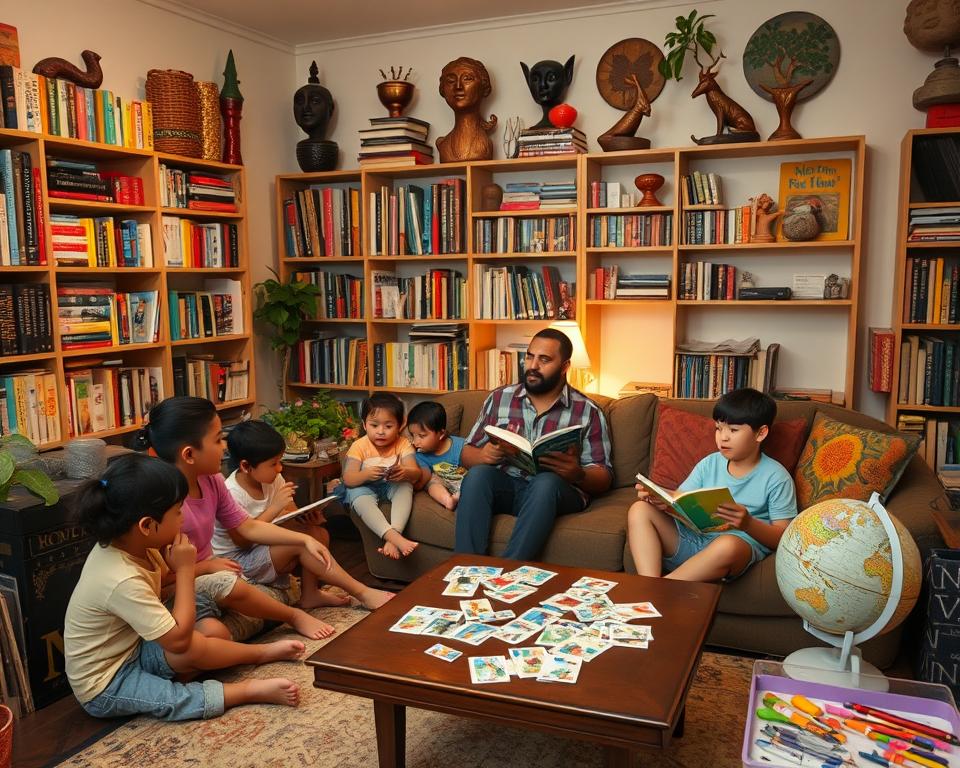
The Role of Native Language in Learning
Keeping the home language alive is key for a child’s language growth and school success. Kids who know their native language well tend to learn English and other languages better. Parents can help by sharing stories, chants, rhymes, and songs from their culture.
Studies reveal that kids who keep up their native language while learning English do better in school over time. Children who speak a language other than English enter U.S. schools with abilities and talents similar to those of native English-speaking children.
- Students who speak English and another language have better job chances, both at home and abroad.
- Children taught in their mother tongue do better in school than those taught in a language they’re not native to.
- A strong base in the mother tongue makes learning a second language easier.
Also, bilingual people show signs of dementia later than those who speak only one language. Those who learn a second language early in life also have a cognitive edge.
Consistent language learning at home enhances retention and fluency.
“Students who learn English and continue to develop their native language have higher academic achievement in later years than students who learn English at the expense of their first language.”
The native language (or first language) plays a foundational role in a child’s overall educational journey. For homeschool parents, understanding and leveraging the native language can significantly enhance their child’s ability to learn new concepts, acquire additional languages, and develop critical thinking skills. This approach can be particularly impactful in multilingual or bilingual settings, where balancing the native language with other languages enriches the child’s cognitive and social growth.
1. Building a Strong Foundation
- Developing Core Skills: The native language forms the base for literacy, communication, and reasoning. When children can express themselves fluently in their native language, it provides a framework for acquiring other skills and subjects.
- Boosting Confidence: Mastery of the native language gives children the confidence to explore new languages and subjects without fear of failure.
- Understanding Complex Concepts: Abstract and complex ideas are easier for children to grasp when taught in a language they already know well.
Language learning at home encourages creativity in children.
2. Supporting Multilingual Education
- Transferable Skills: Many skills learned in the native language—such as reading comprehension, grammar rules, and vocabulary acquisition—transfer to learning a second language.
- Reducing Cognitive Load: Children can focus on mastering new content in other subjects (e.g., math or science) when taught in their native language, as they don’t have to simultaneously decode a new language.
- Creating Bridges: The native language acts as a bridge to second-language learning by providing a familiar reference point for grammar, sentence structure, and idiomatic expressions.
Engaging in activities that promote language learning at home, such as reading together, can enhance vocabulary and comprehension.
3. Cultural Identity and Connection
- Preserving Heritage: Maintaining the native language strengthens a child’s connection to their cultural roots and family traditions.
- Building Empathy: It helps children value their own background while fostering respect for others’ cultures and languages.
- Maintaining Family Bonds: For families with multilingual dynamics, the native language often serves as the primary mode of communication and a tool for fostering familial relationships.
4. Enhancing Cognitive Development
- Critical Thinking: The depth of vocabulary and expressive ability in the native language enhances a child’s capacity to analyze, reason, and articulate ideas.
- Problem-Solving: Thinking through problems in their native language allows children to explore solutions without the barrier of unfamiliar vocabulary.
- Strengthened Memory: Familiarity with native-language structures helps reinforce memory and learning retention.
5. Practical Strategies for Homeschooling with the Native Language
- Teach Core Subjects in the Native Language: Focus on teaching foundational subjects (e.g., math, history, or science) in the native language to ensure deep understanding.
- Incorporate Multilingual Transitions: Once concepts are mastered in the native language, introduce the same topics in a second language to build bilingual proficiency.
- Encourage Native Language Reading: Provide books, stories, and other resources in the native language to strengthen vocabulary and comprehension.
- Use Family Discussions: Incorporate the native language in discussions about daily events, current topics, and family traditions to develop conversational fluency.
- Explore Language Bridges: Compare similarities and differences between the native language and second languages to highlight patterns and connections.
6. Challenges and Solutions
- Fear of Falling Behind in Second Language: Parents might worry that focusing on the native language will delay second-language learning. However, a strong foundation in the native language accelerates second-language acquisition.
- Solution: Dedicate separate times for native and second-language learning, ensuring neither is neglected.
- Limited Resources in the Native Language: Finding homeschool materials in less commonly spoken native languages can be challenging.
- Solution: Use digital tools, libraries, and cultural organizations to locate native-language resources.
- Balancing Multiple Languages: Families in multilingual households may struggle to maintain equal exposure to all languages.
- Solution: Set clear goals for language use, such as using the native language at home and the second language for specific activities.
Implementing language learning at home nurtures academic success.
7. The Native Language as a Tool for Lifelong Learning
- Facilitating Self-Learning: A strong command of the native language equips children with the skills to independently research and learn throughout their lives.
- Enriching Communication: Whether in personal relationships or professional settings, native-language fluency fosters clearer, more meaningful communication.
- Adapting to New Languages: Children who are confident in their native language often find it easier to learn and adapt to additional languages later in life.
Encouraging language learning at home supports emotional development.
In a homeschool setting, the native language is more than a medium of instruction—it’s a cornerstone of personal, academic, and cultural growth. By prioritizing and integrating the native language into the homeschool curriculum, parents can create a supportive environment where their children thrive in multiple languages and develop a deeper connection to their heritage and identity.
Language learning at home helps bridge cultural gaps and fosters appreciation for diversity.
By implementing structured language learning at home, parents can ensure their children achieve their linguistic goals.
Language learning at home is a journey that can lead to lifelong learning and growth.
Encouraging language learning at home can also help develop empathy and understanding of different cultures.
Incorporate fun elements in language learning at home, such as music and dance, to enhance engagement.
Encouraging language learning at home builds confidence and self-expression in children.
Seek opportunities for language learning at home through community events and cultural exchanges.
Language learning at home should include regular practice and conversation to reinforce skills consistently.
Make language learning at home fun and engaging by incorporating games and creative activities.
Utilize educational resources for language learning at home to ensure a comprehensive understanding of the language.
Encourage language learning at home by discussing the stories and experiences that shape your family’s cultural narrative.

By supporting the home language, parents help their kids feel connected to their culture and identity. This support boosts their language skills overall. Embracing the native language is a powerful way to ensure kids do well in school and grow cognitively.
Language Learning at Home: Essential Strategies
Learning a new language can be very rewarding. You can do it from home with the right strategies. Whether you’re teaching your kids or learning a new skill yourself, these tips for teaching languages at home and effective language learning strategies will help.
Creating a language-rich environment is key. Use the target language in your daily life. This could be during meals, bedtime stories, or singing songs. Also, having language playdates with bilingual friends is excellent for real-world practice.
Being consistent is important. Try to practice for 15 minutes each day. This helps build habits and keeps you motivated. Use apps, videos, and podcasts to make your study time effective.
“The secret of getting ahead is getting started. The secret of getting started is breaking your complex, overwhelming tasks into small, manageable tasks, and then starting on the first one.” – Mark Twain
Teaching a new language at home as part of a homeschool curriculum can be both rewarding and challenging. By leveraging effective strategies, parents can create an engaging and successful language-learning environment tailored to their child’s needs and interests. Here’s a guide to essential strategies for homeschooling parents to make language learning at home an enriching experience.
1. Create a Language-Rich Environment
- Immerse in the Target Language: Surround your child with the language by incorporating it into daily life—labels on household items, spoken commands, and casual conversations.
- Introduce Media in the Target Language: Play songs, cartoons, audiobooks, and movies in the target language to build listening skills and familiarity with pronunciation.
- Use Bilingual Books: Start with books that include both native and target languages, progressing to books entirely in the new language as confidence grows.
2. Set Realistic Goals and Milestones
- Define Specific Objectives: Focus on achievable goals such as learning basic vocabulary, forming sentences, or holding a simple conversation.
- Track Progress: Use a progress chart or journal to celebrate milestones like mastering new words, phrases, or grammatical concepts.
- Prioritize Consistency Over Intensity: Short, daily lessons are more effective than sporadic, long sessions.
3. Incorporate Fun and Play
- Language Games: Use flashcards, word-matching games, or apps like Duolingo Kids to make learning enjoyable.
- Role-Playing: Act out scenarios like going to a restaurant or shopping in the target language.
- Songs and Rhymes: Music helps with pronunciation and retention; find catchy songs in the target language that your child can sing along with.
4. Leverage Technology
- Language Apps and Platforms: Tools like Rosetta Stone, Babbel, and LingoDeer provide structured lessons for various age groups.
- YouTube Channels: Educational channels tailored to kids can teach vocabulary and grammar through stories and activities.
- Virtual Tutors and Language Partners: Hire a tutor or connect with native speakers via platforms like italki or Tandem for conversational practice.
5. Blend Language Learning with Other Subjects
- Math in the Target Language: Solve math problems using the new language to reinforce vocabulary related to numbers and operations.
- Science Experiments: Conduct simple experiments while explaining the steps and observations in the target language.
- Art Projects: Create art while discussing colors, shapes, and themes in the target language.
6. Foster Cultural Understanding
- Cook Cultural Dishes: Learn food-related vocabulary by preparing traditional meals from the regions where the language is spoken.
- Celebrate Cultural Events: Observe holidays and traditions from the culture associated with the target language.
- Explore Geography and History: Teach about the countries where the language is spoken to provide context and cultural relevance.
7. Customize the Learning Approach
- Adapt to Learning Styles: Use visual aids for visual learners, songs and audio for auditory learners, and hands-on activities for kinesthetic learners.
- Set Age-Appropriate Tasks: Younger children might enjoy singing and games, while older kids can benefit from reading and writing exercises.
- Focus on Interests: Tailor lessons around your child’s hobbies, such as sports, animals, or technology, to keep them engaged.
8. Encourage Consistent Practice
- Daily Conversations: Incorporate phrases and vocabulary into daily routines, such as saying “Good morning” or “Pass the salt” in the target language.
- Pen Pals or Language Exchanges: Partner with another family or join online groups for conversational practice with peers.
- Review and Revisit: Reinforce learning by regularly reviewing past lessons to strengthen retention.
9. Overcome Common Challenges
- Lack of Fluency in Parents: You don’t need to be fluent; learn alongside your child using resources like language apps and guides.
- Limited Resources: Utilize free online resources, libraries, and printable worksheets for language activities.
- Staying Motivated: Keep lessons fun and interactive to prevent burnout, and remind your child of the long-term benefits of bilingualism.
10. Build Confidence Through Communication
- Encourage Speaking: Focus on communication over perfection—praise effort and progress rather than pointing out mistakes.
- Practice in Real-Life Situations: Use the language during family outings, shopping trips, or virtual cultural experiences.
- Celebrate Achievements: Acknowledge your child’s progress, no matter how small, to keep them motivated and confident.
Language learning at home is a journey that enriches not only your child’s education but also their cognitive and cultural development. With patience, consistency, and these essential strategies, homeschool parents can provide a dynamic language-learning experience that opens doors to lifelong opportunities.
Stay positive and patient while learning. Remember, making mistakes is part of the process. Learning from them is important. Celebrate your small wins to stay motivated.
Embracing language learning at home enhances social skills.
Language learning at home cultivates curiosity in children.
Making language learning at home enjoyable leads to better outcomes.
By using these tips for teaching languages at home and effective language learning strategies, you can have a great learning experience at home. Enjoy the journey, stay consistent, and see the amazing benefits of learning a new language.

Technology and Digital Resources for Language Learning
In today’s world, technology has lots of tools for learning languages at home. Apps, games, and online sites can make learning fun and effective. They help kids dive into learning languages in a fun way.
Language learning at home prepares kids for future global interactions.
When choosing apps, look for ones that keep kids interested. Features like games, exercises, and feedback are great. Apps like Talking Points, Voice Translator, and Microsoft Translator for Education help teachers and parents talk better too.
Language learning at home builds resilience in children.
But, it’s key to use devices wisely. Make sure they’re for learning, not just playing. Mix digital tools with activities like reading and games for a balanced learning space.
“Technology has the power to transform language learning, making it more interactive, personalized, and accessible than ever before.”
There are special tools for English learners and bilingual classrooms. Newsela has texts in English and Spanish, and Khan Academy has its curriculum in 12 languages. BrainPOP ELL and Read&Write are also made for ELL learners.
Other tools like Google Translate and AudioPen help with language skills. Sites like Google Drive and Padlet make learning a team effort.
Language learning at home creates a foundation for community connections.
Language learning at home encourages exploration of new ideas.
Using these apps and tools, parents can make learning languages fun and easy at home.

Daily Routines and Learning Schedules
Adding language learning to your family’s daily life can change everything. Turn regular times like chat or snack time into chances to learn new words. Set aside a “language fun” time each day for games, puzzles, or shows in the target language.
It’s also important to teach good homework habits. Make sure your child has a special study area. Ensure your child doesn’t use screens until they have completed their homework. This helps a lot with learning a new language.
- Set aside 15 minutes each morning for vocabulary practice.
- Do two 20-minute listening sessions during lunch breaks each week.
- Have 50-minute 1-on-1 tutor sessions on Tuesday and Thursday evenings.
- Practice for 30 minutes to an hour each day for quick results.
- For test prep, spend 30 minutes on practice tests in the morning. Then, 45 minutes on grammar and writing in the afternoon. Finally, 1 hour on speaking in the evening.
- Check your progress every month.
Make language learning a priority by practicing for 10-15 minutes a day. It’s better to study a little often than a lot at once. Use your commute time for reading and listening to improve your language skills.
“Integrating language learning into your daily tasks is a powerful way to reinforce new language skills.”
Use a Fixed-Fluid Schedule to find the perfect balance. This way, your language learning plans can change as your life does. Remember, learning a language is a journey. With the right daily habits, you’ll get there.
Establishing a structured yet flexible daily routine is a cornerstone of successful homeschooling. For parents, creating a balanced schedule ensures that learning objectives are met while accommodating each child’s unique needs and maintaining harmony at home. Here’s a guide to designing effective daily routines and learning schedules in a homeschool setting.
1. Importance of Daily Routines in Homeschooling
- Provides Structure: A routine helps children know what to expect, creating a sense of security.
- Encourages Discipline: Regular schedules build time management skills and self-discipline.
- Maximizes Productivity: Structured days reduce wasted time and ensure focus on key learning goals.
- Balances Academics and Life Skills: A daily routine allows for the integration of academics, chores, hobbies, and relaxation.
Language learning at home fosters a love for languages and encourages ongoing engagement with new cultures.
Explore different cultures through language learning at home to enrich your child’s understanding and appreciation of diversity.
Language learning at home can be supported by using technology, apps, and online resources tailored for young learners.
Incorporating language learning at home into everyday life helps children feel more connected to their culture and identity.
2. Factors to Consider When Designing a Schedule
- Child’s Learning Style: Adapt the routine to visual, auditory, or kinesthetic learners.
- Age and Attention Span: Younger children may need shorter learning periods with frequent breaks, while older kids can handle longer sessions.
- Family Dynamics: Consider the needs of siblings, working parents, and household responsibilities.
- Core Subjects vs. Electives: Prioritize essential subjects like math and reading while leaving room for creative or interest-driven activities.
3. Sample Daily Routine
Here’s a sample schedule to inspire your homeschool routine:
Morning
- 8:00 AM – Breakfast and Morning Routine: A healthy breakfast followed by personal hygiene and light chores.
- 9:00 AM – Morning Meeting: Discuss the day’s plan, review the previous day, and set goals.
- 9:30 AM – Core Subjects: Focus on math and language arts, when energy levels are high.
- 10:30 AM – Snack Break: A quick break with a healthy snack.
- 10:45 AM – Science or History: Dive into hands-on experiments or storytelling for engaging learning.
Midday
- 12:00 PM – Lunch and Free Time: A relaxed lunch followed by unstructured play or quiet time.
- 1:00 PM – Creative Subjects: Art, music, or a second language to stimulate creativity.
Afternoon
- 2:00 PM – Electives or Hobbies: Coding, cooking, or any interest-driven activity.
- 3:00 PM – Outdoor Time or Physical Activity: Physical education through play, sports, or nature walks.
- 4:00 PM – Independent Study or Reading: Encourage children to explore personal interests or read independently.
Evening
- 5:00 PM – Family Time: Engage in games, discussions, or collaborative projects.
- 6:00 PM – Dinner and Cleanup: Share the responsibilities of meal preparation and cleanup.
- 7:00 PM – Evening Review and Reflection: Review the day’s learning and plan for tomorrow.
- 8:00 PM – Relaxation and Bedtime: Wind down with quiet activities like reading or light stretches before bed.
4. Tips for Creating a Successful Homeschool Routine
- Start with a Basic Framework: Begin with broad time blocks and refine as you observe what works best.
- Be Consistent but Flexible: Stick to routines while being open to adjustments for unexpected events or opportunities.
- Incorporate Breaks: Allow time for snacks, physical activity, and relaxation to maintain focus and energy.
- Use a Visual Schedule: Post a colorful, easy-to-read schedule that children can reference throughout the day.
5. Integrating Life Skills and Chores
- Chore Charts: Assign age-appropriate chores as part of the daily routine to teach responsibility.
- Real-Life Learning: Use cooking, gardening, and budgeting as practical lessons that integrate math, science, and critical thinking.
- Collaborative Family Time: Involve children in planning meals or organizing family events to build teamwork and communication skills.
6. Balancing Academics and Free Play
- Structured Learning: Reserve specific times for focused academic work.
- Unstructured Play: Allow free play to encourage creativity and relieve stress.
- Screen Time Management: Balance educational screen time with offline activities.
7. Adapting to Multiple Children
- Staggered Schedules: Alternate one-on-one time with independent work for siblings.
- Group Learning: Teach subjects like science or art to all children together when possible.
- Use Independent Resources: Provide self-guided materials for older children while working with younger ones.
8. Evaluating and Adjusting the Routine
- Weekly Check-ins: Review what worked and what didn’t to improve the schedule.
- Gather Feedback: Ask children how they feel about the routine and make adjustments as needed.
- Celebrate Progress: Acknowledge milestones and successes to keep everyone motivated.
A well-crafted daily routine is the backbone of effective homeschooling. It fosters discipline, promotes a balanced lifestyle, and creates an environment where learning thrives. By tailoring the schedule to your family’s unique needs, you can ensure that homeschooling is both productive and enjoyable for everyone.

Storytelling and Reading Activities
Learning a new language is a journey that never ends. Storytelling and reading are excellent ways to help kids along the way. They not only grab their attention but also help them learn new words and phrases.
Start reading to your child from the very beginning. It helps them get better at reading, understanding, and speaking. Encourage them to tell stories and share their family’s history. Pictures can also help them learn new words and meanings.
- Engage in activities like drawing, storytelling, and playing games at home to support early literacy development.
- Exposing children to nursery rhymes can be particularly beneficial for their language and early literacy skills.
- Listening to audiobooks or having parents read aloud can increase the amount of language children hear and understand.
As kids get older, play word games and talk about word meanings. This helps improve their reading skills. Create a place where they can talk and learn more about language.
“Storytelling is a powerful tool in education due to its ability to inspire, connect, and teach.”
Using technology can also help families with language learning. It can speed up progress and give kids more knowledge. But it’s important to choose good online resources to make sure they’re helpful.

The key to learning a language at home is understanding, making connections, and talking. By doing storytelling and reading activities, you help your child grow their language skills. And you help them develop a love for learning that lasts a lifetime.
Music, Games, and Interactive Learning
Learning a new language can be fun with music, games, and interactive activities. Singing songs and learning rhymes in a new language helps with pronunciation. It also connects you to the culture.
Encouraging consistent language learning at home nurtures discipline.
Apps and games like Dinolingo offer many interactive activities for kids. They keep young learners excited about learning a new language.
The Dinolingo app has over 35,000 activities in 50 languages. It includes videos, games, songs, audiobooks, and stories. A family subscription lets up to 6 users learn together. It has a 4.8-star rating on Google and offers a 7-day free trial.
Traditional games like Bingo and Charades can also help with language learning. They make learning fun and interactive. Board games like Kloo and Spanish Bingo make learning a language part of the game.
“Motivation is a key driver of success in language learning; motivated individuals are more consistent in practicing a language and learn more than their less motivated peers.”
Using music, games, and interactive activities makes learning a language fun. It helps kids love languages and learn better.
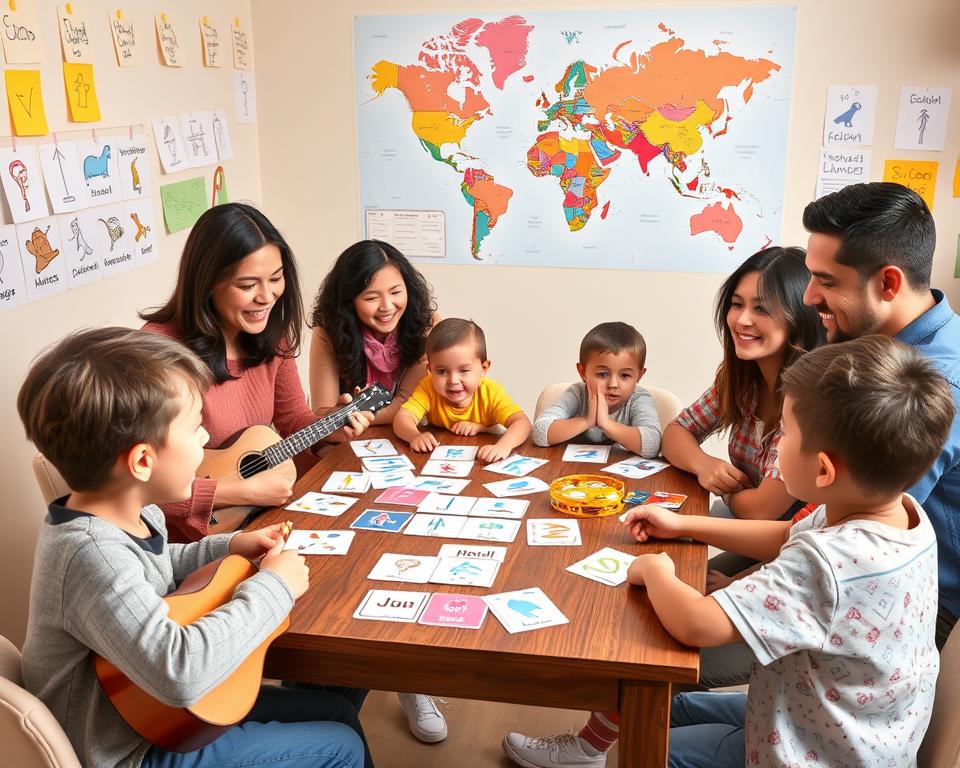
It’s important to mix structured lessons with fun activities. This way, each child learns in their own way. With the right resources, parents can help their kids become great at languages.
Overcoming Common Learning Challenges
Learning a new language is rewarding but can be tough. Families with English Language Learners (ELLs) face many hurdles. These include logistical problems and cultural differences. However, we can overcome these challenges with the right help.
One big challenge is the language barrier. Limited English skills make it challenging for parents to talk to teachers and help with homework. Schools can help by offering home-school coordinators who provide translation services.
Another issue is when children lack education in their first language. This makes learning a new language harder. Schools can help by sending bilingual newsletters and holding meetings at community centers.
- Getting to school can be challenging due to transportation and work schedules. Schools can help by initiating home visits and accommodating parents’ work schedules.
- Cultural differences can also make learning a new language tough. Schools can create a welcoming environment by respecting and valuing diversity.
Working together, schools and families can overcome many language learning obstacles. Using translation apps and other technology helps. By meeting the needs of ELL families, we can help them succeed in learning new languages.

Community and Cultural Integration
Language learning is greatly enhanced by community and cultural integration. Engaging with the local community and embracing cultural diversity boosts a child’s language skills and learning experience.
Attending local cultural festivals and concerts is a wonderful way to foster cultural integration. These events help families connect with others who share their language, creating a supportive network. Parents can also organize their own events, inviting family and community members.
Encourage your child to share their cultural heritage with teachers, friends, and peers. This builds cultural awareness and reinforces their native language and identity. Using community resources like the library in the curriculum supports language learning and cultural integration.
Parents should strive to create a positive environment where language learning at home is viewed as an exciting challenge.
Research shows that English Language (EL) students do better when they connect new English words to their home language. Teachers and parents can use this to build strong relationships and improve language skills.
Through language learning at home, children develop essential skills that will benefit them in their academic and social lives.
“According to Student Achievement Partners’ e2 Instructional Practice Framework™, culturally responsive-sustaining instruction includes the promotion of ‘cultural pluralism¹, encouraging students to inquire into and sustain their racial, ethnic, and linguistic identities.”
Making language learning personal and interesting can make it exciting. Personalized and interest-driven learning experiences increase student engagement and improve language skills.
However, there’s a challenge in cultural integration: a lack of diverse cultural resources. Many programs use outdated materials that limit perspectives and perpetuate stereotypes. To fix this, language learning institutions need to create and use authentic, current cultural materials.
By embracing cultural integration in language learning and using community resources for language education, we can create a supportive environment for multilingual learners to succeed.
Tracking Progress and Celebrating Success
Learning a new language is a journey with ups and downs. It’s key to stay motivated by celebrating each success. By tracking your progress and acknowledging your wins, you grow and stay inspired.
Begin by setting clear, reachable goals. Goals give direction and focus to your language learning journey. Instead of vague goals like “improve my French,” set specific targets. For example, “be able to talk about my favorite fashion designer in French.” Help your child pick goals that match their interests and needs.
- Set realistic deadlines for your goals, like “be able to have a basic conversation in Italian by the end of this term.”
- Celebrate every small step forward. It brings your child closer to their language goals.
Use a language learning app, journal, or spreadsheet to track progress. Regularly reviewing your child’s progress helps spot strengths and areas for growth. Encourage your child to celebrate their wins, like mastering 50 new words or speaking for 5 minutes daily.
“Every step forward, no matter how small, brings them closer to their language goals.”
Creating a positive, supportive environment helps your child see language learning as a journey of growth. Celebrate their achievements and watch their confidence and skills grow.
Learning a new language at home is a journey that needs patience, consistency, and engagement from parents. By making a language-rich environment, using available resources, and staying positive, parents can help a lot. Every story, song, or conversation helps build a strong language base.
Parents should face challenges with courage and celebrate every win. Raising kids who speak multiple languages is rewarding. It boosts their thinking skills and connects them to their culture. This journey makes kids confident and skilled in speaking many languages.
The path of learning a new language at home is full of chances to grow and find new things. By using the tips and resources in this guide, parents can help their child grow. This sets them up for success in school and life.
30 Tips & Strategies for Language Learning At Home
General Approaches
- Set Clear Goals: Decide on specific language goals, such as learning 50 words or being able to hold a basic conversation.
- Create a Schedule: Dedicate consistent time daily or weekly to language learning.
- Incorporate the Language into Daily Life: Use the target language during routine activities like meals, playtime, or bedtime.
- Use Visual Aids: Label objects around the house in the target language.
- Celebrate Progress: Reward achievements to keep your child motivated.
Interactive Activities
- Play Games: Use language-focused games like flashcards, memory matching, or language apps.
- Watch TV Shows or Movies: Choose age-appropriate programs in the target language with or without subtitles.
- Sing Songs: Learn nursery rhymes or popular songs in the target language.
- Read Books Together: Use bilingual books or books entirely in the target language.
- Practice Conversations: Role-play simple scenarios like shopping or dining out.
Leveraging Technology
- Use Language Learning Apps: Apps like Duolingo Kids, Gus on the Go, or Mondly for Kids make learning interactive.
- Listen to Audiobooks: Choose audiobooks in the target language to improve listening skills.
- Watch YouTube Channels: Find educational channels that teach the target language.
- Join Online Classes: Enroll in virtual language courses designed for kids.
- Explore Virtual Pen Pals: Connect your child with peers who speak the target language.
Cultural Immersion
Language learning at home fosters self-expression and creativity.
- Cook Together: Prepare dishes from countries where the language is spoken and learn food-related vocabulary.
- Celebrate Cultural Festivals: Learn about and celebrate holidays from the culture associated with the language.
- Explore Music and Dance: Teach your child traditional songs or dances in the target language.
- Create a Cultural Corner: Set up a space in your home with books, flags, and artifacts from the culture.
Daily Practices
- Use Flashcards: Practice vocabulary daily with physical or digital flashcards.
- Speak the Language at Home: Encourage basic greetings, commands, and common phrases.
- Keep a Language Journal: Help your child document new words, sentences, or experiences in the target language.
- Play Pretend: Pretend you’re in a country where the language is spoken and only use that language during play.
- Use Repetition: Repeating words and phrases reinforces learning.
Social Interaction
- Join Language Groups: Look for local or online language meetups for kids.
- Interact with Native Speakers: Hire a tutor or connect with family friends who speak the language.
- Create a Language Exchange: Partner with another family learning your native language in exchange for teaching theirs.
Advanced Strategies
- Incorporate STEM: Teach basic math or science concepts in the target language.
- Set Up a Learning Corner: Designate a specific area with resources like posters, books, and games.
- Practice Patience and Consistency: Language learning is a long-term process—progress takes time, and consistency is key.
Key Takeaways
- Understand the challenges faced by Spanish-speaking ELLs in learning English sounds and vowels.
- Discover the benefits of oral storytelling and wordless picture books for developing vocabulary and language skills.
- Explore how rhymes, songs, and chants can contribute to improving intonation and word stress.
- Learn about the accessibility and importance of public libraries for language learners and their families.
- Recognize the value of engaging children in meaningful conversation for oral language development.
Source Links
- Empowering ELL Parents & Families at Home – https://www.colorincolorado.org/article/empowering-ell-parents-families-home
- Creating a Language-Rich Environment at Home: A Guide to Supporting Language Learning – https://tessais.org/how-to-support-language-learning-at-home/
- The Benefits of Bilingual Education | American University – https://soeonline.american.edu/blog/benefits-of-bilingual-education/
- The Benefits of Being Bilingual (PDF) – https://www.ed.gov/media/document/bilingual-enpdf-0
- Why Bilingualism Is a Superpower! – Richmond Family Magazine – https://richmondfamilymagazine.com/parenting/bilingualism-families-languages-learning/
- 10 Easy Ways to Cultivate a Language Rich Environment in Your Home – https://amshq.org/Blog/2021_10_30-10-Easy-Ways-to-Cultivate-a-Language-Rich-Environment-in-Your-Home
- PDF – https://www.ecasd.us/getmedia/71e96296-cf29-4b07-a6d0-a39e27c45b32/Creating-A-Language-Rich-Home-Environment.pdf
- Creating a Language-Rich Environment at Home – TT Academy – https://thettacademy.co.uk/tips-for-parents-creating-a-language-rich-environment-at-home/
- Why is it Important to Maintain the Native Language? – IDRA – https://www.idra.org/resource-center/why-is-it-important-to-maintain-the-native-language/
- The Power of Mother Tongue: Its Impact on Language Learning and Understanding. – Language Unlimited – https://www.languagesunlimited.com/the-power-of-mother-tongue-its-impact-on-language-learning-and-understanding/
- Strategies For Learning A Language At Home – https://strommeninc.com/strategies-for-learning-a-language-at-home/
- 7 Strategies To Learn A Language At Home – https://www.babbel.com/en/magazine/7-ways-to-learn-a-language-without-a-teacher
- Learning Languages – Learning Center – https://learningcenter.unc.edu/tips-and-tools/learning-a-second-language/
- How to Use Technology to Support ELLs in Your Classroom | Common Sense Education – https://www.commonsense.org/education/articles/how-to-use-technology-to-support-ells-in-your-classroom
- Helpful Online Resources for Teaching ELLs – https://www.edutopia.org/article/helpful-online-resources-teaching-ells/
- How to Learn a New Language at Home, According to Language Experts – https://nymag.com/strategist/article/how-to-learn-languages-at-home.html
- Language study plan: Your guide to creating the perfect language learning schedule [+ template] – https://preply.com/en/blog/language-study-planner/
- How to set up a successful language-learning schedule – https://www.smartlanguagelearner.com/language-learning-schedule/
- My CRAZY 5AM Language Routine – StoryLearning – https://storylearning.com/blog/my-crazy-5am-language-routine
- Supporting Your Child’s Literacy Development at Home – https://improvingliteracy.org/brief/supporting-your-childs-literacy-development-home/index.html
- How to Engage Language Learners With Storytelling – Growing with Proficiency – https://growingwithproficiency.com/how-to-engage-language-learners-with-storytelling/
- Language Learning for Kids – Dinolingo | Best Language Learning App for Kids – https://www.dinolingo.com/?srsltid=AfmBOop6DyBua_UF2qjmVgtcTcqXs5ODWRxhG81k45Au1cngqd1dE1j9
- 16 Language Learning Games & Activities: Fun & Effective – https://preply.com/en/blog/at-home-language-learning-games/
- Kids Language Learning Fun – https://www.childrenslearningadventure.com/index.php/blog/kids-language-learning-fun
- 5 Tips to Overcome Language Barriers – https://www.gooverseas.com/blog/improve-foreign-language-skills
- 9 Common Language Learning Challenges and How to Overcome Them | Pep Talk Radio – https://www.peptalkradio.com/language-learning-challenges/
- How to Overcome Common Challenges in English Language Learning – Golders Green College – https://www.englishlanguagecollege.co.uk/2024/02/06/how-to-overcome-common-challenges-in-english-language-learning/
- Leveraging Language: How can students who are learning English use… – https://practices.learningaccelerator.org/problem-of-practice/leveraging-language-how-can-el-students-use-their-home-language-in-a-personalized-classroom
- Bridging Language Learning, Culture, and Interest – Student Achievement Partners – https://learnwithsap.org/peersandpedagogy/bridging-language-learning-culture-and-interest/
- learner: Integrating Cultural Context in Language Learning: A Comprehensive Approach for 2024 – https://scalar.chapman.edu/scalar/learner/integrating-cultural-context-in-language-learning-a-comprehensive-approach-for-2024
- Help your students to set goals for language learning success – https://sanako.com/help-your-students-to-set-goals-for-language-learning-success
- You’re so good at languages already – celebrate it! – https://5minutelanguage.com/2015/04/06/youre-so-good-at-languages-already/
- 5 Tips to help you set achievable language learning goals – Learn English with Camille – https://learnenglishwithcamille.com/learn-english-blog/5-tips-to-help-you-set-achievable-language-learning-goals/?srsltid=AfmBOooBboZOwbcDDXowStxA4GNKUmSwlIkK9cej9v-29CZUjJF7LJb9
- The Home Language: An English Language Learner’s Most Valuable Resource – https://www.colorincolorado.org/article/home-language-english-language-learners-most-valuable-resource
- To Speak or Not To Speak My Language: Supporting Families’ Home Language Practices – https://www.naeyc.org/resources/pubs/tyc/fall2023/supporting-families-home-language
- Many Languages, One Classroom: Supporting Children in Superdiverse Settings – https://www.naeyc.org/resources/pubs/tyc/dec2018/supporting-children-superdiverse-settings

